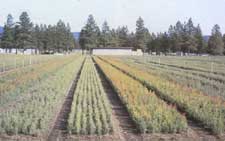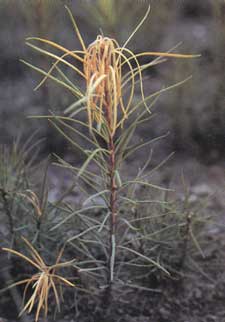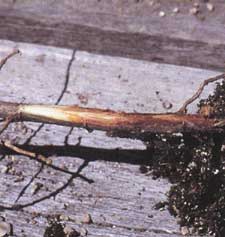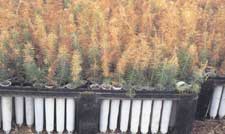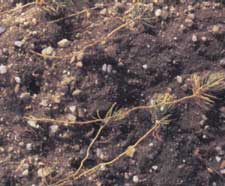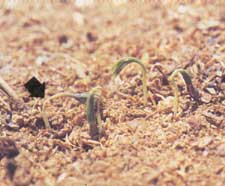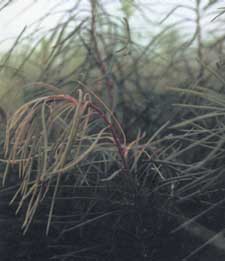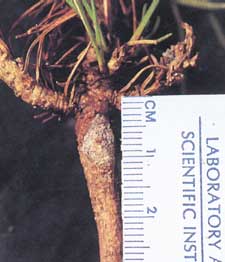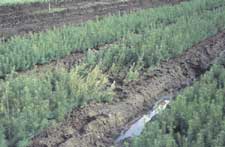Environmental and Mechanical DamageThomas D. Landis - Western Nursery Specialist, Region 6, USDA Forest Service, Portland, OR. Cordell C.E., Anderson R.L., Hoffard W.H., Landis T.D., Smith R.S. Jr., Toko H.V., 1989. Forest Nursery Pests. USDA Forest Service, Agriculture Handbook No. 680, 184 pp.
Diagnosing abiotic damage is difficult because whatever caused the damage may have taken place some time before. Many fungi colonize dead tissue, and they may be mistaken for the primary cause. Check weather records and ask local residents about severe weather incidents. Similar injury to several different species is often related to the environment. Check nursery beds for minor depressions, exposed areas, or changes in soil types. Mechanical injury can usually be diagnosed by studying the damage pattern and consulting nursery personnel. Specific Problems Frost - Frost usually results from unseasonably cold weather in the spring or fall when new growth is still succulent. Damage rarely occurs until the temperature of plant tissues reaches approximately 28 oF, although the severity of damage depends on seedling frost hardiness. Depressions in nursery beds may function as frost pockets. Frost damage may result in stunted, bushy seedlings when terminal buds are repeatedly killed. Winter-Burn - Winter-burn is actually desiccation rather than cold injury. It occurs when transpiration rates exceed water uptake from cold or frozen soil. Container seedlings are especially susceptible if stored over winter in exposed locations. Affected foliage turns bright red and appears scorched (fig. 57-4); tip dieback can occur in severe cases. Winter-burn is most common on conifers in exposed locations during warm, windy weather.
Mechanical - Roots and stems can be injured by cultivation, root pruning, and weeding. The pattern of mechanical damage is usually obvious, and nursery personnel can help identify specific incidents. Harvesting seedlings, particularly with mechanical harvesters in wet, heavy soils, is a major cause of injury to root systems (fig. 57-9). Prevention Frost - Acclimatization is the best prevention against cold injury. Design growing schedules to allow a natural "hardening" period before damaging fall frosts occur. Late applications of nitrogen fertilizer may prolong seedling succulence, whereas potassium fertilization has been reported to promote hardening. Some nurseries use drought-stressing to reduce height growth of conifer seedlings and induce dormancy during late summer. Lath shelters or straw mulches can physically protect seedlings but are labor intensive. Frost protection to 25 oF can be achieved with sprinkler irrigation because water releases heat as it freezes on the foliage. Winter-Burn - Orient snow fences and windbreaks perpendicular to prevailing winter wind to reduce exposure. Cover seedlings with bedframes, which are effective but expensive. Thick protective mulches provide protection but must be removed in the early spring to prevent mold damage to the covered seedlings. Frost-Heaving - Use thick mulches to insulate seedbeds and to reduce frost action. Seedling growth schedules should encourage root growth on small first-year seedlings. Schedule root wrenching or pruning to allow adequate time for new root formation before winter. Leveling and raising seedbeds and selecting coarse-textured sandy soils will encourage drainage and reduce frost-heaving. Heat - Schedule either fall or early spring sowing to allow small, succulent seedlings to develop a protective bark layer before soil temperatures reach damaging levels. North-south seedbed orientation and proper seedbed densities will also encourage mutual shading of seedlings. Reduce soil surface temperatures by shading seedbeds and using light-colored mulches that reflect sunlight and dissipate heat. Water should be applied frequently and lightly, as dictated by soil surface temperatures. Drought - Proper irrigation will minimize moisture stress. Young seedlings require more frequent irrigation than older stock. Irrigate at night in arid climates. Organic matter increases the water-holding capacity of sandy soils, and seed-bed mulches can be used to retard moisture evaporation and increase water infiltration rates. Windbreaks reduce transpirational losses by decreasing wind exposure. Wind Abrasion - Use natural or artificial windbreaks to reduce windspeed and surface mulches to prevent soil erosion. Irrigate during windy periods to help stabilize surface soils. Seedbeds should be oriented parallel to prevailing winds. Mechanical - Well-trained, conscientious machinery operators are the only true solution to mechanical damage. Precision tractor work such as root pruning, lifting, and cultivation should be performed when soil conditions are near optimum. Selected References Aldhous. J.R. 1972. Nursery practice. For. Comm. Bull. 43. London: Her Majesty's Stationery Office. 184 p. Levitt, J. 1980. Responses of plants to environmental stresses, vols. 1 and 2. New York: Academic Press. 497 p. and 606 p. Stoeckeler, J.H.; Slabaugh, PE. 1965. Conifer nursery practice in the prairieplains. Agric. Handb. 279. Washington. DC: U.S. Department of Agriculture. 93 p. |
Forest Pests: Insects, Diseases & Other Damage Agents |

|
|
